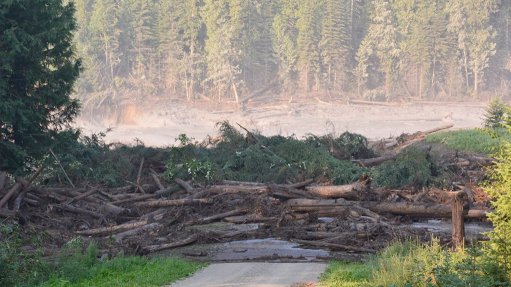
Photo by: Cariboo Regional District Emergency Operations Centre
TORONTO (miningweekly.com) – In the wake of Imperial Metals’ Mount Polley mining disaster, the British Columbia government on Monday ordered independent third-party reviews of 98 permitted tailings impoundments at 60 operating and closed metal and coal mines in the province.
Under the Health, Safety and Reclamation Code for Mines in British Columbia, the deadline for a normal yearly dam safety inspection would have been March 31, 2015, and would not have required an independent third-party review.
However, the chief inspector of mines accelerated the date for inspections to December 1 and added the requirement for an independent review by a qualified, third-party professional engineer from a firm not associated with the tailings facility.
The chief inspector’s order also included a requirement for a third-party review of the dam consequence classifications by December 1. A dam’s consequence classification was based on the potential impact on population, the environment, cultural values and infrastructure should it fail, and was set according to the Canadian Dam Association Dam Safety Guidelines.
Under the order, mines with high, very high or extreme consequence classifications would be required to have their emergency preparedness and response plans reviewed by an independent third party.
INDEPENDENT INVESTIGATION
Further, the provincial government, with the support of the Soda Creek Indian Band and Williams Lake Indian Band, also ordered an independent engineering investigation and inquiry into the Mount Polley tailings pond breach two weeks ago, which sent billions of litres of mine waste and fine sand into the pristine environment.
The investigation would be undertaken by a panel of three experts that would examine the cause of the Mount Polley tailings dam failure, including geotechnical standards, design of the dam, maintenance, regulations, inspection regimes and other matters the panel deemed appropriate.
This panel had been given the ability to compel evidence and Energy and Mines Minister Bill Bennett had been given permission to require Imperial Metals to cover costs of the inquiry.
The independent engineering investigation and inquiry would be the first step of a two-step process, the government said. The independent panel would first conduct an investigation and provide recommendations through a final report by January 31, 2015, which would determine why the tailings dam failed, after which the government and First Nations would receive recommendations.
The report’s findings would only then be shared with the public, while its recommendations would be implemented by government as needed and where appropriate to ensure such an incident “never” happened again.
ENVIRONMENTAL CONCERN
The environmental disaster came in the face of several government and industry-backed energy and resource developments that were already coming under closer examination from Aboriginal groups and environmentalists, who worried that the risks might overshadow the rewards.
British Columbia’s Ministry of Energy and Mines (MEM) revealed on Monday that officials investigated an incident on May 24, which had found the height of the Mount Polley tailings pond was above regulation. This occurred in a different area of the tailings pond than the recent dam failure.
The MEM issued Mount Polley with an advisory, stating that the distance between the water elevation and the crest of the dam (freeboard) was less than 1 m. The tailings pond level was subsequently returned to authorised levels and freeboard was about 2.4 m when last measured.
The MEM said mine records showed that the operation was carrying out visual dam inspections and measuring freeboard at an acceptable frequency, including daily measurements after the incident.
On August 30, 2012, the MEM issued a warning to Mount Polley Mining Corporation for failure to report exceeding the height of effluent for the perimeter pond. This perimeter pond overflowed, releasing about 150 m3 of effluent into the environment over 13 hours.
Meanwhile, provincial Environment Minister Mary Polak said in a separate statement on Monday that she had suspended the environmental assessment of Pacific Booker Minerals' proposed Morrison copper/gold mine, pending the outcome of the independent expert engineering investigation and review panel in relation to the tailings dam breach at the Mount Polley mine.
Under the Environmental Assessment Act, the Environment Minister could suspend an assessment until the outcome of any investigation, inquiry, hearing or other process that is being conducted by the British Columbia government and was material to the assessment.
The proposed C$517-million Morrison mine is located 65 km north-east of Smithers. The project is a conventional openpit mine with a planned extraction rate of about 30 000 t/d and a mine life of 21 years.